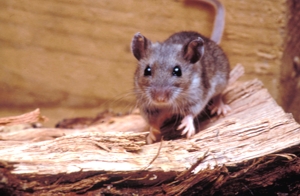Rats and mice
 Rodents can be a common problem in the U.S. Common house mice,
field mice, and rats can be found in homes and businesses. Control measures can consist of bait boxes, live catch
traps, sticky and snap traps, and exclusion measures. The best mice control program will vary depending on the circumstances of each infestation.
Rodents can be a common problem in the U.S. Common house mice,
field mice, and rats can be found in homes and businesses. Control measures can consist of bait boxes, live catch
traps, sticky and snap traps, and exclusion measures. The best mice control program will vary depending on the circumstances of each infestation.
Common house mice are small and abundant in most of the U.S. Having mice in the house can cause big problems. Mice droppings, saliva, and fur can contaminate food products. House mice can nest in walls and even in furniture and baby mice can be found in the nest. House mice are excellent climbers and have sharp senses of hearing and smell. House mice are usually light gray with black eyes and a long hairless tail. Baits will often be used to kill house mice. The best mice control is achieved with a thorough inspection, usually followed by a clean-out service to eliminate the existing problem. A regular mouse control service can prevent or reduce the infestation of mice.
Field mice are usually dark brown and slightly larger than the common house mouse. These mice are abundant and may find their way indoors in the fall and winter. These mice may contaminate food products or damage items by chewing them. Having field mice in the house is not as common as having house mice in the house. Field mouse pest control services are similar to house mice control services.
Norway rats or just brown rats are large dark brown, reddish or black rats that can be a serious pest problem and health risk. Norway rats inhabit the 48 U.S. states and thrive in the presence of humans. Large cities are know for problems with these large rats. The average Norway rat weighs about 1 pound and may be 6 to 8 inches long, not counting the tail. Norway rats are not native to the United States but were introduced in the mid 1700's and now have spread to most of the country.
Roof rats are similar in appearance to norway rats but are slightly smaller and have a shorter tail. Although both norway rats and roof rats are good climbers, the roof rat prefers to nest in high places such as attics and eaves while the Norway rat is more at home on the ground. Roof rats are uncommon in the mid-west, most rats in this area are Norway rats.





